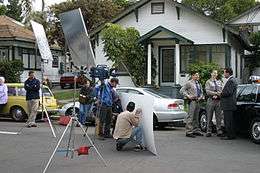Video production
Video production is the process of creating video by capturing moving images (videography), and creating combinations and reductions of parts of this video in live production and post-production (video editing). In most cases the captured video will be recorded on the most current electronic media such as SD cards. In the past footage was captured on video tape, hard disk, or solid state storage. Video tape capture is now obsolete and solid state storage is reserved for just that, storage. It is now distributed digitally in formats such as the Moving Picture Experts Group format (.mpeg, .mpg, .m4p), QuickTime (.mov), Audio Video Interleave (.avi), Windows Media Video (.wmv), and DivX (.avi, .divx). It is the equivalent of filmmaking, but with images recorded digitally instead of on film stock.
Overview
Practically, video production is the art and service of creating content and delivering a finished video product. This can include production of television programs, television commercials, corporate videos, event videos, wedding videos and special-interest home videos. A video production can range in size. Examples include:
- a family making home movies with a prosumer camcorder,
- a one solo camera operator with a professional video camera in a single-camera setup (aka a "one-man band"),
- a videographer with a sound person,
- a multiple-camera setup shoot in a television studio
- a production truck requiring a television crew for an electronic field production (EFP) with a production company using set construction on the backlot of a movie studio.
Shooting styles and techniques include:
- using a tripod (aka "sticks")[1] for a locked-down, stable shot;
- hand-held for a larger frame of motion to attain more jittery camera angles or looser shots to depict natural movement
- incorporating various camera angles such as the Dutch angle (see Mission Impossible), Whip pan (see the opening of Hot Fuzz) and Whip zoom (see the Kiddo/Driver fight in Kill Bill Vol. 2);
- on a jib or crane that smoothly soars to varying heights as seen in the finale of the movie Grease;
- with a Steadicam for smooth movement as the camera operator incorporates moving cinematic techniques such as moving through rooms, as seen in The Shining.

Corporate video
Corporate video production covers a wide range of purposes from corporate Communication, Training and Education, videotaping conferences and conventions, products and services, and sales. A popular type of corporate shoot is known as the "candids" or "happy-face" video, in which a multiple-day event is covered by a video crew, including speakers, break-out sessions, awards ceremonies and local recreational activities in which the conventioneers participate. An on-site editor then creates a short video presentation that is shown before the close of the convention. Many associations take advantage of the convention venue to gather interviews of their principals, setting up a green screen or other type of background in a secluded room.
Video productions video tape or memory-based recording device or an edited version from a website video, optical disc, magnetic tape, or portable video device.
Television broadcast

Betacam SP video production was the broadcast television standard from the early 1980s up until the beginning of the 21st Century when many television stations began using digital media to shoot, transmit and store High-definition (HD) footage. Two styles of producing video are ENG - Electronic news-gathering and EFP - Electronic field production. Television broadcast productions include television commercials, infomercials, newscasts, entertainment shows, documentaries, news magazines, sitcom and reality shows. They may be distributed by broadcast syndication.
Event video
Video production can be used at sporting, school, stage, wedding, church, and similar events to provide recordings of the events. Event video productions range in distribution from a wedding video that is custom made for a bride and groom and their immediate family and friends, to a dance recital where dozens to hundreds of videos are sold to individual dancers. Event video production can also be used to broadcast events live to viewers at home such as a press conference or concert. Video of live events can be sent by microwave or a satellite truck from the event location to a television studio in order to be broadcast.[2]
Video production for distance education
Video production for distance education is the process of capturing, editing, and presenting educational material specifically for use in on-line education. Teachers integrate best practice teaching techniques to create scripts, organize content, capture video footage, edit footage using computer based video editing software to deliver final educational material over the Internet. It differs from other types of video production in three ways: 1. It augments traditional teaching tools used in on-line educational programs. 2. It may incorporate motion video with sound, computer animations, stills, and other digital media. 3. Capture of content may include use of cell phone integrated cameras and extend to commercial high-definition Broadcast quality cameras. The primary purpose of using video in distance education is to improve understanding and comprehension in a synchronous or asynchronous manner.[3]
Webcasting is also being used in education for distance learning projects; one innovative use was the DiveLive[4] programs. Detailing an exploration of a notable shipwreck, Nautilus Productions has a webpage reading,
″In the fall of 2000 Rick Allen's Nautilus Productions co-produced with Bill Lovin of Marine Grafics a groundbreaking, week long live internet broadcast known as QAR DiveLive from the Blackbeard wreck site.[5] For the first time ever, live video and audio was broadcast from an underwater archaeological site to the World Wide Web. Students were able to watch the underwater archaeology in real time and ask questions of the scientists exploring the shipwreck. The twice-daily live distance learning programs reached an estimated 1600 students from as far away as Canada during the five days of broadcasting. In October of 2001 Allen and Lovin again co-produced QAR DiveLive 2001. This time the interactive webcasts from the seafloor and conservation laboratories of the Queen Anne's Revenge Shipwreck Project reached over 3600 students and another 2700 remote viewers from fifteen states and 2 countries during the five days of broadcasts.″
Internet video production

Many websites include videos. These videos are not necessarily produced online, although there are many video production tools that allow the production of videos without actually using a physical camera. An example of this is using the YouTube video editor to create a video using pre-existing video content that is held on the platform under Creative Commons license.
Video content is being used in an ever growing range of contexts on websites. There are testimonial videos, web presenter videos, help section videos, interviews, parodies, product demonstrations, training videos, thank you videos and apology videos.
Many internet marketing videos are made in home based environments, however businesses too can use internet videos for the purpose of interacting with the audience. There are two main types of internet marketing videos: transactional videos, aiming to sell a product to a customer, and reference videos, aiming to keep the customer on the website.
Individual internet marketing videos are primarily produced in-house and by small media agencies, while a large volume of videos are produced by big media companies, crowdsourced production marketplaces or in scalable video production platforms. Most types of internet marketing videos serve the purpose of interacting with the audience, and there are two main types of internet marketing videos: transactional videos, aiming to sell a product to a customer, and reference videos, aiming to keep the customer on the website.
See also
References
- ↑ "Archived copy". Archived from the original on March 24, 2011. Retrieved March 23, 2011.
- ↑ Zettl, Herbert. Video Basics 6. Belmont: Wadsworth Publishing, 2009.
- ↑ Moore, M. G., & Kearsley, M. G. (2012). 'Distance education: A systems view of on line learning'. (3rd ed.). Belmont, CA: Wadsworth/Cengage Learning.
- ↑ "Live from Morehead City, it's Queen Anne's Revenge". ncdcr.gov.
- ↑ "Queen Anne's Revenge". Nautilus Productions.
External links
| Library resources about Video production |
 Media related to Video production at Wikimedia Commons
Media related to Video production at Wikimedia Commons- Video production at DMOZ